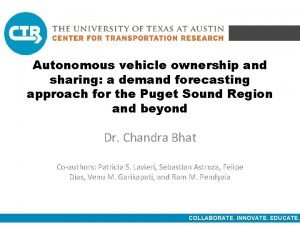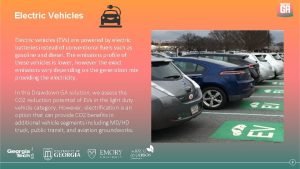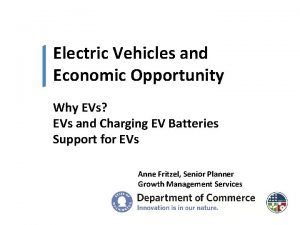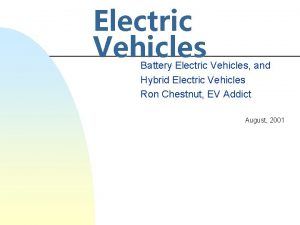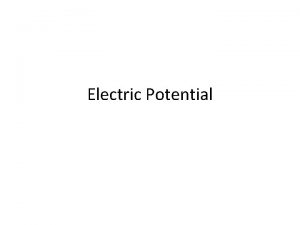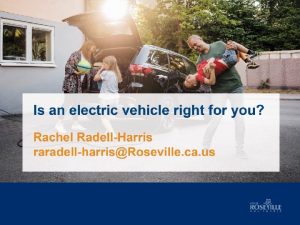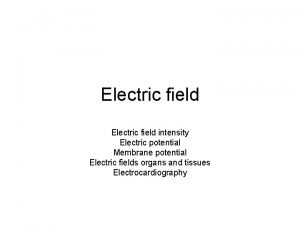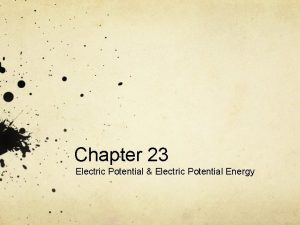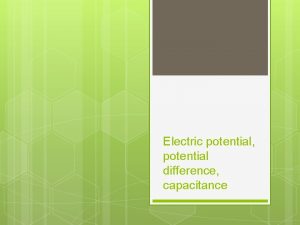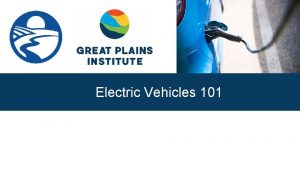Estimating Potential Demand for Electric Vehicles EVs Michael















- Slides: 15

Estimating Potential Demand for Electric Vehicles (EVs) Michael K. Hidrue and George R. Parsons Camp Resources XVII Wrightsville Beach, NC June 24 -25, 2010 Sponsored by: US Department of Energy, Office of Electricity Delivery and Reliability

Outline • • • Objective Study design Estimation results WTP estimates Conclusion 1

Objectives • Estimate potential market demand for EVs • Assess the value of adding V 2 G on demand for EVs • V 2 G vehicles are special type of EVs that allow people to sell power from their batteries back to electric companies. 2

Study Design • Web based choice experiment • National Survey, N=3029 • Sample resembles national census data • Latent class random utility model 3

Sample EV Choice Set 4

Results: Number of Latent Classes • BIC identified two latent classes EV class GV class • The EV class has positive EV constant, high value for fuel saving and tend to be green • The GV class has negative EV constant, low value for fuel cost saving and tend not to be green 5

Results: Class Membership Model Variable Coefficient T-stat Odds ratio Constant Young (25 -35 yrs old) -2. 9 -12 6. 2 0. 06 Middle age (36 -55 yrs old) 0. 26 2. 4 1. 3 Expected gas price in 5 years 2. 6 1. 07 Change in life style & shopping habit : Major 0. 07 1. 15 7. 8 3. 2 Change in life style & shopping habit: Minor 0. 71 5. 8 2. 0 Having access for installing charger 1. 14 10. 1 3. 1 Expected next vehicle: Hybrid 1. 06 10. 4 2. 9 Multicar household -0. 12 -1. 2 0. 9 College (>=B. A) 0. 06 0. 7 1. 1 Male 0. 34 3. 7 1. 4 0. 78 2. 2 Four more variables… 6

Results: Vehicle Choice Model Parameters Attributes GV class EV class Coef. T-stat. EV constant -4. 02 -10. 0 0. 47 4. 0 Yea saying -0. 08 -0. 27 -5. 0 Price -1. 8 E-04 -6. 0 -1. 04 E-04 -25. 1 Pr *pr on GV 4. 1 E-07 0. 04 1. 1 E-06 6. 9 Fuel cost -0. 16 -1. 4 -0. 34 -9. 3 Prob. Weighted Implicit Prices -$9, 337* -$2, 764 *=value of yea saying is subtracted from the constants 7

Results: Vehicle Choice Model Continued Parameters Attributes GV class Coef. EV class T-stat. Coef. T-stat. Probability weighted Implicit Prices Driving range (Ref=75 mi) 150 mi 0. 81 3. 8 0. 44 7. 3 $5, 177 200 mi 0. 89 4. 3 0. 84 14. 6 $8, 134 300 mi 1. 34 6. 4 1. 14 17. 4 $11, 391 Charging time for 50 mi (Ref=10 hrs) 5 hours 0. 57 2. 7 0. 09 1. 6 $2, 136 1 hour 1. 04 5. 3 0. 45 8. 3 $5, 858 10 minutes 1. 31 6. 8 0. 74 13. 6 $8, 567 8

Results: Vehicle Choice Model Continued Attributes Parameters GV class Coef. EV class T-stat. Coef. T-stat. Probability weighted Implicit Prices Acceleration relative to respondent’s next car (Ref=20% slower) 5% slower 0. 58 2. 8 0. 06 1. 04 5% faster 0. 92 4. 2 0. 28 4. 7 $4, 372 20% faster 1. 16 5. 3 0. 50 8. 2 $6, 521 $1, 957 Pollution relative to respondent’s next car (Ref=25% lower) 50% lower 0. 11 0. 52 0. 05 0. 84 $636 75% lower 0. 33 1. 9 0. 08 1. 3 $1, 428 95% lower 0. 53 2. 8 0. 28 4. 8 $3, 333 9

Top 10% WTP Estimates Assumptions: Fuel cost=$1. 00/gal equivalent Acceleration=5% slower Pollution=75% lower 10

Comparing WTP Estimates with Battery Cost Estimates 11

Comparing WTP and Battery Cost Estimates 12

Comparing WTP and Battery Cost Estimates in the Presence of Subsidy 13

Conclusion • Driving range, charging time and performance are significant drivers of EV choice • Green life style, hybrid buyer, outlet access, expected gas price and age are significant predictors of EV choice • Multicar household, college education and regions are not significant predictors of EV choice • People will pay premium for some EV designs • For EVs to compete on the market, battery cost has to decline substantially. 14
 Electric potential energy
Electric potential energy Equipotential lines
Equipotential lines Electric potential energy and potential difference
Electric potential energy and potential difference Electric potential and potential difference
Electric potential and potential difference Potential energy due to point charge
Potential energy due to point charge Pe=-qed
Pe=-qed Energy in an electric field
Energy in an electric field Electric potential from electric field
Electric potential from electric field Forecasting demand for autonomous vehicles
Forecasting demand for autonomous vehicles Why is water potential measured in pascals
Why is water potential measured in pascals How to find pressure potential
How to find pressure potential Water potential definition
Water potential definition Graded potential vs action potential
Graded potential vs action potential Graded potential and action potential
Graded potential and action potential Definition of graded potential
Definition of graded potential Action potential definition
Action potential definition








